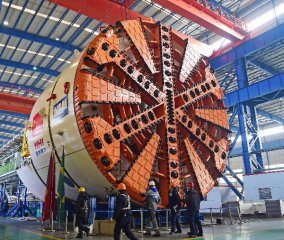
Fiscal revenue growth rates are offering a peek into the resilience and potential of China's economy, as data released around the provincial legislative sessions reveals a stark contrast in the figures across the country's 31 provinces.
Guangdong, the former pioneer of China's economic reform and opening up over the past three decades, continues to lead with a total fiscal revenue of 936 billion yuan (142 bln U.S. dollars), the highest among all provinces, posing a year-on-year rise of 12 percent, more than double the country's average of 5.8 percent.
Other provinces and municipalities that also saw double-digit fiscal revenue rises include Shanghai, Hubei, Jiangxi ,Beijing and Jiangsu. By contrast, Heilongjiang and Shanxi, both heavily dependent on resource and heavy industry, saw their fiscal revenue contract by 9.8 percent and 10.4 percent respectively in 2015.
Economic officials say the provinces with strong revenue readings are reaping rewards from their successful transition from low-profit manufacturing to high-end and service industries .
"The bulging wallets are a result of accelerating the transformation of the economic model," said Tang Huihao, chief economist at Shanghai Statistics Bureau, commenting on the 13.3-percent revenue growth of the eastern financial hub.
Tang said the service sector contributed 67.8 percent to Shanghai's GDP, with profits rising by 29.4 percent in 2015. The city's industrial sector also recorded profit rates higher than the national average thanks to successful industrial restructuring.
Similarly, Guangdong's surging government income is attributed to the take-off of local high-tech industries and a booming service sector that have picked up the slack caused by the waning exports.
The southern province, once a major garment and toy exporter, is now home to 11,000 high-tech enterprises. The province set up 399 high-tech incubators in 2015 and maintains a cutting edge by processing several core technologies such as metamaterial, cloud computing, stem cells, gene sequencing, new-generation mobile communication, photoelectric display, digital audio-video and robotics.
"Guangdong's economic transformation started early, and a number of high-tech companies have grown into big tax payers," said Yao Lu, a revenue official with Guangdong's finance department. "The province's advanced economic structure has greatly improved risk resistance, especially in tough times," Yao said.
China's coastal provinces, which have been catapulted into the economic top echelon thanks to the country's opening-up policies, are still leading the country in economic upgrading. They boast strengths in modern services, tech industries and high-end manufacturing, said Zhang Bin, an economic researcher at Chinese Academy of Social Sciences.
"They may still be the bellwethers of the country's future economic transition," Zhang said. As for the regions where fiscal revenues contracted, the challenge will be how to make use of limited fiscal capital to ensure public services and inspire enterprises to innovate to create new growth.
Comparing Heilongjiang to a polio patient, Chen Yongchang, director of the Science and Economic Advisory Committee of the Heilongjiang Province, said that for a long time, the energy industry has contributed more than half to the province's economic growth while new high-tech and modern service industries were barely expanding.
"With an imbalanced economic structure, the province can hardly prosper amid economic slowdown," said Chen. He suggested the provinces that fell behind in fiscal revenue growths reduce their reliance on a single industry and focus more on industrial innovation.






















Latest comments